Fluid-Solid-Thermal Coupled Freezing Modeling Test of Soil under the Low-Temperature Condition of LNG Storage Tank
Abstract
:1. Introduction
2. Experimental Simulation
2.1. Model Test Design
2.1.1. Overall Model of the Test Chamber
2.1.2. Storage Tank Model
2.1.3. Freezing Equipment
2.1.4. Seepage Control System
2.1.5. Data Acquisition System
2.2. Test Materials and Methods
2.2.1. Test Materials
2.2.2. Test Methods
2.3. Experimental Step
- The natural sandy soil in Shanghai was chosen as the research material for this project, which was taken from the sandy soil extracted from a construction site in Shanghai. We took some small samples to determine the main physical parameters, as in Section 2.2.1 of this paper. The rest of the sandy soil was spread out in the sun on the ground to dry for 3 days; after obtaining dry sand, the sand was retained for backup.
- The main structure of the test chamber was built. The test chamber is shown in Figure 9.
- PVC hose was laid, with a magnetic level gauging the setup of the piping. The PVC hose was connected using anchors to the bottom of the test chamber, as shown in Figure 10. We used a porous plastic sheet to separate the tank area from the main experimental area. Fine gauze was used on the mouth of the pipe, to avoid sand loading in the pipeline interfering with the determination of liquid level height. In the middle of the experimental chamber body was double-layer glass plate and hollow space (such as Figure 9b) with suspended LNG tanks, such as shown in Figure 7. Rolling tape was used in the PVC tube for the PT100 platinum resistance temperature sensor. We used the lowest ground pressure sensor. The displacement sensor was fixed to the chamber in advance, using copper wire to connect the displacement sensor with 4 horizontal PVC hoses in the chamber for zero displacement of the sensor.
- At the same time, for the soil loading (Figure 11) and earth pressure sensor layout, the loading soil height was equal to the height of the earth pressure sensor layout, in order to bury the earth pressure sensor as shown in Figure 12 We used AB adhesive to lay the earth pressure sensor on the PVC hose to ensure that the location of the measurement point was stable. Then, we finished filling the main part of the chamber. A low-temperature thermostatic reaction bath instrument and LNG storage tank with a rubber water pipe connected to the outer insulation layer were loaded with a tap water testing instrument; the storage tank was used to complete the cycle, cleaning up the circulating water, after the low-temperature thermostatic reaction drying treatment.
- After the completion of soil filling and the use of nylon rope to connect the remaining displacement gauge and PVC hose, the length of the nylon rope was adjusted to ensure that the rope was in horizontally taut and could not immediately be pulled to disrupt the displacement gauge state. The displacement gauge and magnetic level gauge were set to zero, and the ambient temperature and humidity sensor was tied over the displacement gauge and tank. The ambient air pressure thermometer was attached.
- Water was added to the tank once, through the magnetic levitation level meter pipeline, and the level meter readings were observed to ensure that about half the height of the chamber was filled with soil before stopping adding of the water. After the water was completely infiltrated into the chamber, pile loading was performed on the top layer of soil, using large cement blocks; the top layer of soil was completely covered to completely compact the soil. The displacement meter was observed, and when the value of the displacement meter of the PVC hose buried in the soil body did not change anymore, the pile load was removed.
- The booster circulating water pump was assembled, and the connecting hoses on both sides were inserted into the magnetic level gauge setting tubes on both sides of the chamber to test the pump’s circulation function.
- Then, 99% concentration of industrial alcohol was loaded into the low-temperature constant temperature reaction bath to test circulation performance, and the following tasks were completed: leveling the sand, cleaning the site of static test chamber, and closing the site. After all instruments in the test site have stabilized, the quiescent phase ends, and the test preparation phase is complete.
- The tank level was set at 1/2 the tank height, i.e., open the valve at 1/2 the tank height and close the other valves. The freezing temperature was set to −40 °C, and the freezing time to 15 days.
3. Experimental Results
3.1. LNG Tank Temperature Boundary Conditions
- Cryostat reaction and cooling the liquid to low temperature needs a certain time, about 2.5 h;
- The output temperature of circulating liquid is −39 °C to −41.5 °C, and the input temperature of circulating liquid is −37.5 °C to −39 °C;
- The cycle of the circulating liquid is approximately 1 h, the test chamber will additionally cool the liquid to approximately −41.5 °C, and the instrument will operate again at approximately −38.5 °C.
3.2. Test Seepage Field Conditions
3.3. Temperature Field of the Soil
3.4. Soil Stress Field
3.5. Soil Placement Field
4. Discussion
- The test sand seepage flow velocity field measurement results: for the infinite boundary field water seepage velocity, , and the finite boundary field seepage velocity, .
- The temperature field distribution of the test sand soil body is developed with the storage tank as the core, and the outward freezing field mainly occurs in the range of one to two times the diameter of the storage tank extended outside the boundary of the storage tank model, which is consistent with the numerical simulation results. The temperature field is distributed in the direction of seepage. The decrease in temperature is slower in areas with high water levels compared to those with low water levels. The temperature field has a downward protrusion and an elliptical overall shape.
- The stress field distribution of the test sand soil body: the horizontal maximum freezing pressure, and the vertical maximum freezing pressure appeared in different locations. It is analyzed that this is due to the boundary conditions of the test chamber. The freezing pressure exerted on the soil vertically is greater than the horizontal pressure. The maximum vertical freezing pressure occurs within a range of 1 to 2.5 times the diameter of the storage tank, with a maximum value of 468.80 kPa. The pressure direction is from the inside of the storage tank towards the surrounding area. During the freezing process, the horizontal maximum pressure in the tank extends outwards to a distance of three to four times the tank diameter, with a maximum value of 138.81 kPa. The pressure spreads outwards from the tank in all directions, causing the soil pressure concentration area to develop uniformly and continuously.
- The distribution test of sand and soil displacement in the field: the storage tank boundary extends outward from one to two times the diameter range of the soil body. There is more obvious displacement within the diameter range of the soil body, while almost no displacement is observed within the two-fold diameter range of the soil body. Therefore, there is no obvious freezing and soil displacement phenomenon. Furthermore, the horizontal seepage field exhibits a hysteresis effect on freezing and expansion displacement, with the effect occurring later at higher water levels than at lower water levels. Soil displacement was greater in areas with shallower vertical burial depths, while areas with deeper burial depths experienced smaller soil displacement.
5. Conclusions
- The earth pressure test only set up horizontal and vertical earth pressure monitors on the higher side of the liquid level, failing to form a comparison with the lower side of the liquid level. Therefore, further study is needed to conduct a relevant model comparison test.
- The test soil is only selected from the natural fine sand in Shanghai, and the study fails to analyze the sand according to its proportions. A similar model of sand under the freezing temperature field needs to be further researched.
Author Contributions
Funding
Data Availability Statement
Conflicts of Interest
References
- Sotoodeh, K. Chapter Two—LNG technology. In Cryogenic Valves for Liquefied Natural Gas Plants; Gulf Professional Publishing: Houston, TX, USA, 2022. [Google Scholar]
- Chen, H.; Yang, G.; Wu, J. A multi-zone thermodynamic model for predicting LNG ageing in Large cryogenic tanks. Energy 2023, 283, 128503. [Google Scholar] [CrossRef]
- Zheng, N. Natural gas will enter a golden age of development. Refin. Technol. Eng. 2015, 45, 41. (In Chinese) [Google Scholar]
- He, T.; Chong, Z.R.; Zheng, J.; Ju, Y.; Linga, P. LNG cold energy utilization: Prospects and challenges. Energy 2019, 170, 557–568. [Google Scholar] [CrossRef]
- IEA. World Energy Outlook 2023; IEA: Paris, France, 2023; Available online: https://www.iea.org/reports/world-energy-outlook-2023 (accessed on 27 October 2023).
- The LNG Industry Giignl ANNUAL Report. 2019. Available online: https://giignl.org/publications (accessed on 27 May 2019).
- Goto, S.; Nakano, M. Development and construction of the world’s first buried LNG underground tank. Concr. Eng. 1997, 15, 17–35. (In Japanese) [Google Scholar]
- Ibashiri, M. Concrete at cryogenic temperatures. Concr. Eng. 1979, 17, 20–23. [Google Scholar]
- Miyamoto, K. Study on rationalisation of design of reinforced concrete structures for LNG underground tanks. Proc. JSCE 1997, 4, 79–89. (In Japanese) [Google Scholar]
- Sato, Y.; Kobayashi, K.; Takagi, H.; Atsuhiro, F. Study on level 2 earthquake resistance of LNG underground tanks. Proc. JCI 2007, 29, 1009–1101. (In Japanese) [Google Scholar]
- Zou, D.L.; Sun, J.G.; Wu, H.; Hao, Y.F.; Wang, Z.; Cui, L.F. Experimental and numerical studies on the impact resistance of large-scale liquefied natural gas (LNG) storage outer tank against the accidental missile. Thin Wall Struct. 2021, 158, 107189. [Google Scholar] [CrossRef]
- Zou, D.L.; Hao, Y.F.; Wu, H.; Sun, J.G.; Xu, L.; Li, J.G. Safety assessment of large-scale all steel LNG storage tanks under wind-borne missile impact. Thin Wall Struct. 2022, 174, 109078. [Google Scholar] [CrossRef]
- Peng, Q.; Wu, H.; Zhang, R.F.; Fang, Q. Numerical simulations of base-isolated LNG storage tanks subjected to large commercial aircraft crash. Thin Wall Struct. 2021, 163, 107660. [Google Scholar] [CrossRef]
- Park, E.; Jung, Y.; Song, W.; Lee, D.; Chung, S. Pilot study on the underground lined rock cavern for LNG storage. Eng. Geol. 2010, 116, 44–52. [Google Scholar] [CrossRef]
- Lee, H.S.; Lee, D.H.; Kim, H.Y.; Choi, Y.T. Design criteria for thermo-mechanical stability of rock mass around lined rock cavern for underground LNG storage. Tunn. Undergr. Space Technol. 2006, 21, 337. [Google Scholar] [CrossRef]
- Cha, S.; Lee, K.; Bae, G.; Lee, D.; Gatelier, N. Analysis of rock drainage and cooling experiments for underground cryogenic LNG storage. Eng. Geol. 2007, 93, 117–129. [Google Scholar] [CrossRef]
- Jung, Y.; Park, E.; Chung, S.; Kim, H. Coupled hydro-thermal modeling of ice ring formation around a pilot LNG cavern in rock. Eng. Geol. 2011, 118, 122–133. [Google Scholar] [CrossRef]
- Kim, J.H.; Lee, M.; Jang, W.; Lee, J. Strain behavior of very new high manganese steel for 200,000 m3 LNG cryogenic storage tank. Energy 2023, 271, 126889. [Google Scholar] [CrossRef]
- Duan, Z.; Xue, H.; Gong, X.; Tang, W. A thermal non-equilibrium model for predicting LNG boil-off in storage tanks incorporating the natural convection effect. Energy 2021, 233, 121162. [Google Scholar] [CrossRef]
- Zhang, Y.; Du, Z. Seismic Response Analysis of LNG Storage Tank under Fluid Structure Coupling Condition. Henan Technol. 2022, 40, 875–885. (In Chinese) [Google Scholar]
- Trainor, M. Celebrating the centenary of the health and safety laboratory: Enabling a better working Britain. Process Saf. Environ. Prot. 2011, 89, 353–359. [Google Scholar]
- Ye, Z.; Zhang, Z.; Jing, H. Technology on Leakage Monitoring and Analysis of LNG Storage Tank. Energy 2021, 233, 121162. [Google Scholar] [CrossRef]
- Yang, Y.M.; Kim, J.H.; Seo, H.S.; Lee, K.; Yoon, I. Development of the World’s Largest Above-Ground Full Containment Lng Storage Tank. In Proceedings of the 23rd World Gas Conference, Amsteradam, The Netherlands, 5 June 2006. [Google Scholar]
- Rama Subba Reddy Gorla. Probabilistic analysis of a liquefied natural gas storage tank. Appl. Therm. Eng. 2010, 30, 2763–2769. [Google Scholar] [CrossRef]
- Li, H.; Xu, J.; Li, Z. Calculation and analysis of temperature field of full-capacity LNG storage tank. Nat. Gas Pet. 2012, 30, 15–19+97–98. (In Chinese) [Google Scholar]
- Zhang, L.; Fang, J.; Ke, S. Analysis of heat leakage from large full-capacity LNG storage tank. Cryog. Supercond. 2018, 46, 21–27. (In Chinese) [Google Scholar] [CrossRef]
- Chen, K.L.; Xi, L.Y.; Xie, Z.L.; Wu, J.P.; Fang, W. Development of new 7%Ni steel for LNG storage tanks. Oil Gas Storage Transp. 2021, 40, 1181–1186+1200. (In Chinese) [Google Scholar]
- Marwan, A.; Zhou, M.M.; Abdelrehim, M.Z.; Meschke, G. Optimization of artificial tunneling in the presence of seepage flow. Comput. Geotech. 2016, 75, 112–125. [Google Scholar] [CrossRef]
- Gao, J.; Feng, M.; Gao, Q. Analysis of heat-fluid-solid (THM) coupling for freezing construction of metro contact channel. Glacial Permafr. 2013, 35, 904–912. (In Chinese) [Google Scholar]
- Khaledi, K.; Mahmoudi, E.; Datcheva, M.; Schanz, T. Stability and serviceability of underground energy storage caverns in rock salt subjected to mechanical cyclic loading. Int. J. Rock Mech. Min. 2016, 86, 115–131. [Google Scholar] [CrossRef]
- Lai, Y.; Wu, Z.; Zhu, Y.; Zhu, L. Nonlinear analysis of temperature field, seepage field and stress field bogey problem in cold tunnel. J. Geotech. Eng. 1999, 21, 529–533. (In Chinese) [Google Scholar]
- Zimmerman, R.W. Coupling in Poroelasticity and Thermoelasticity. Int. J. Rock Mech. Min. Sci. 2000, 37, 79–87. [Google Scholar] [CrossRef]
- Wilson, C.R.; Witherspeon, P.A. Steady State Flow in Rigid Networks of Fractures. Water Resour. Res. 1974, 10, 328–335. [Google Scholar] [CrossRef]



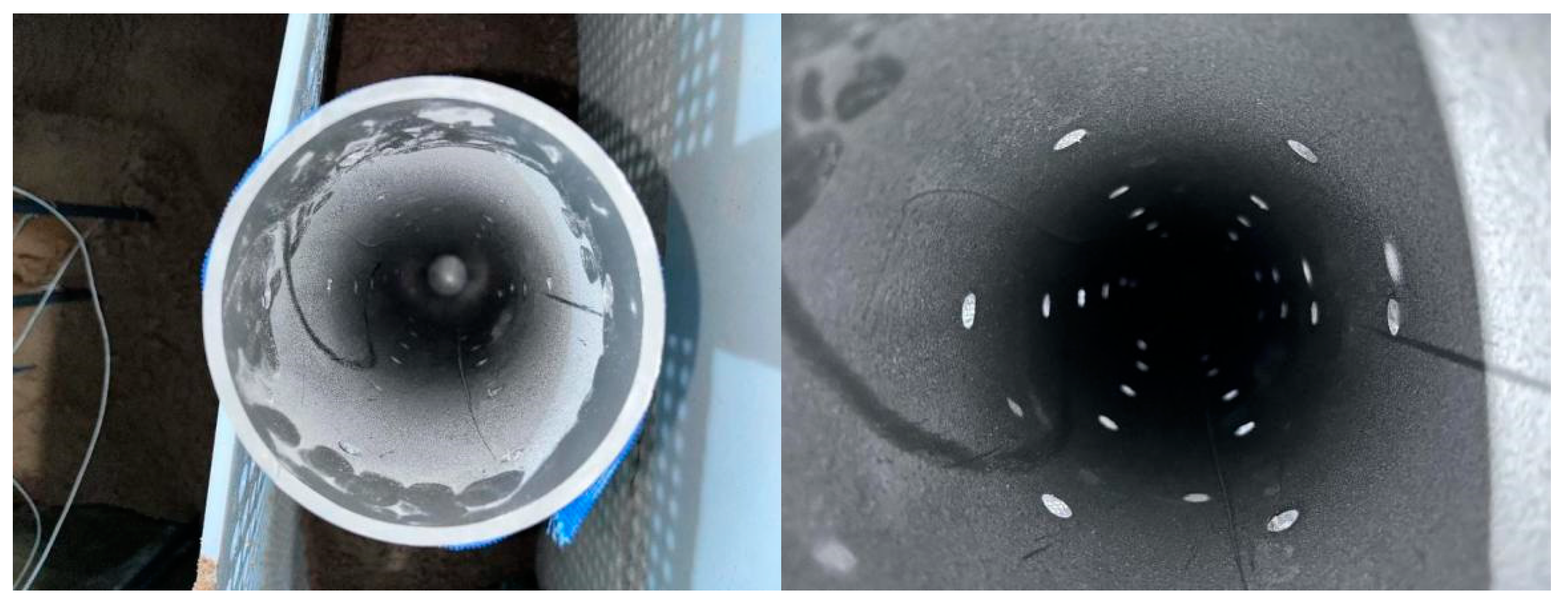
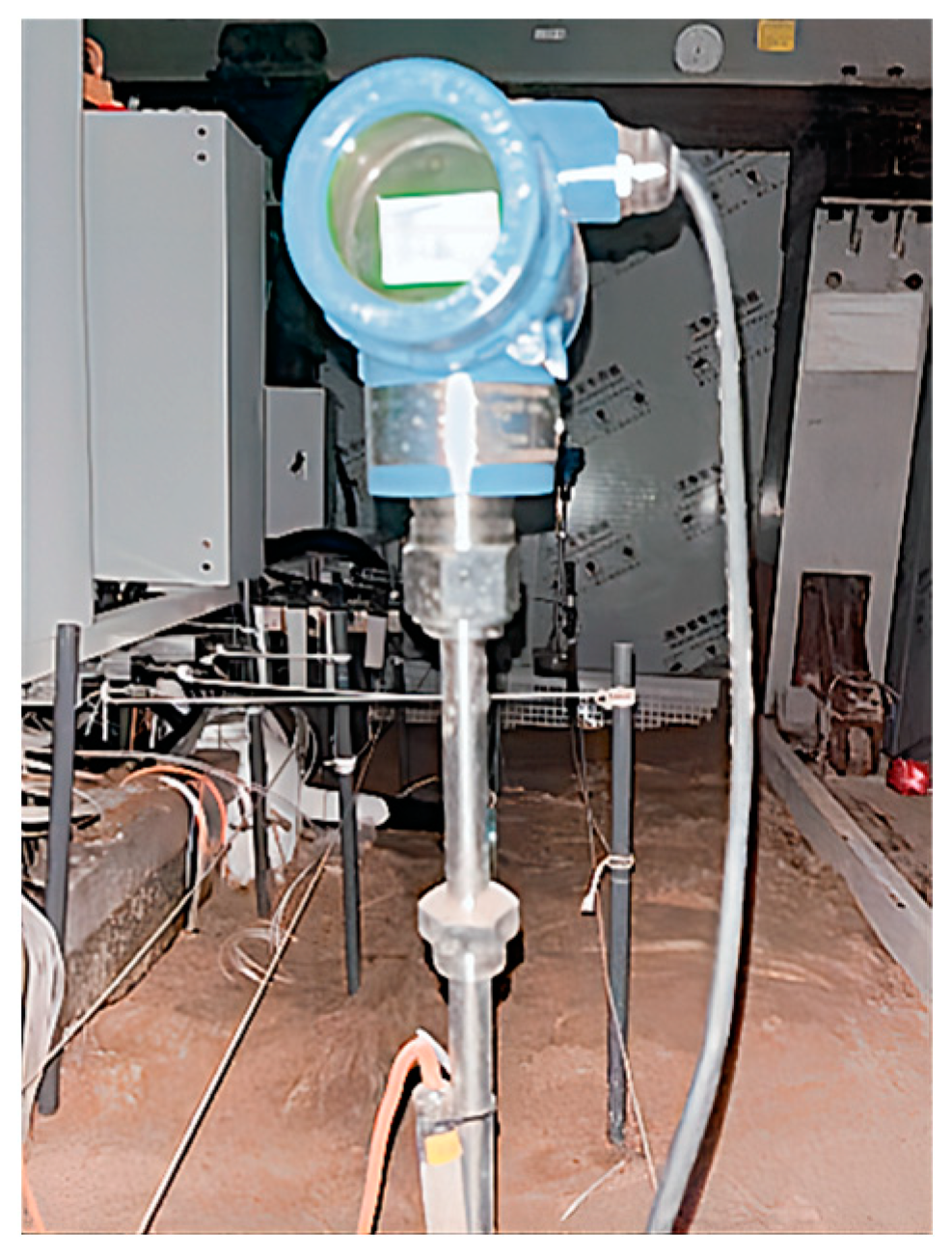

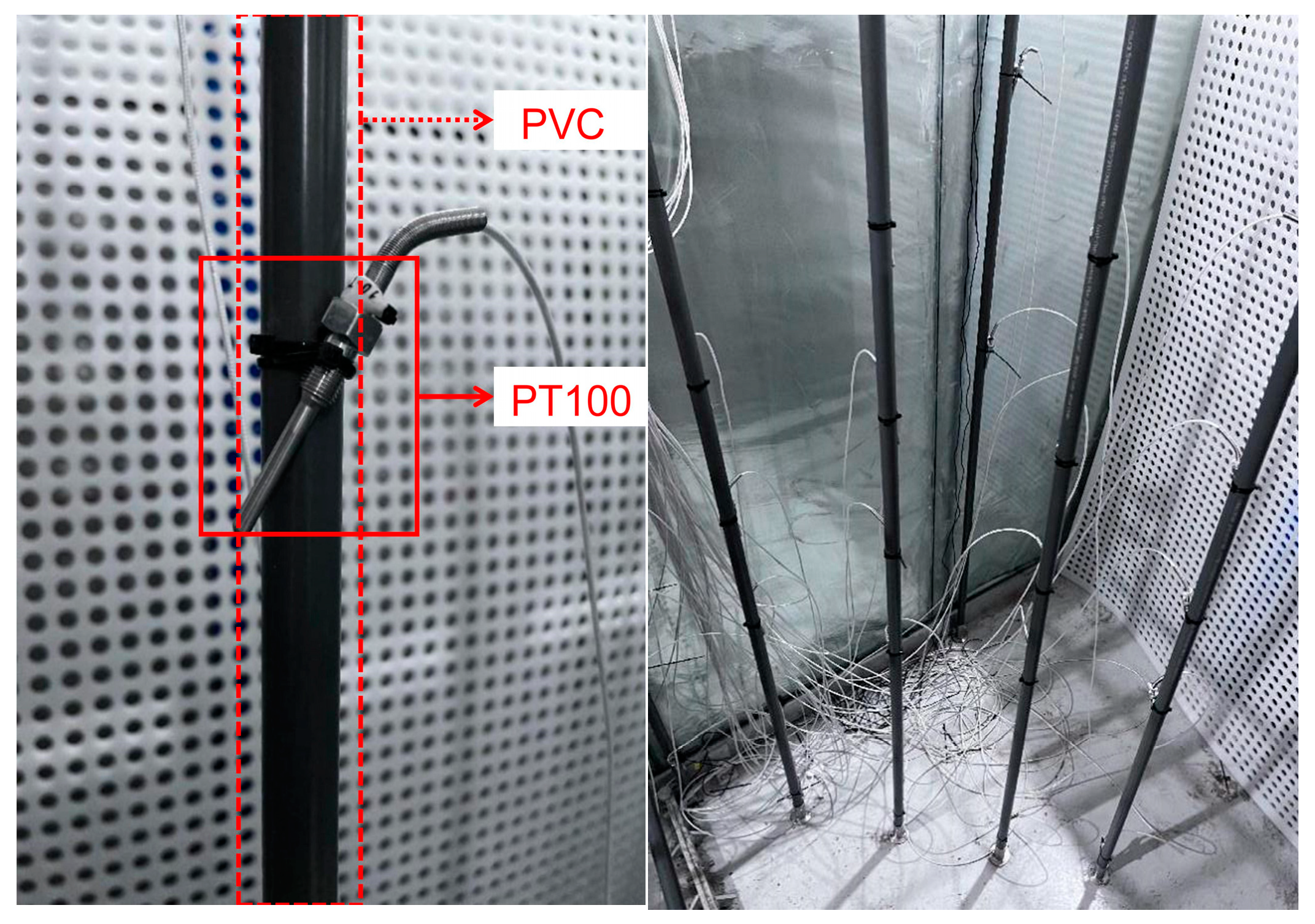
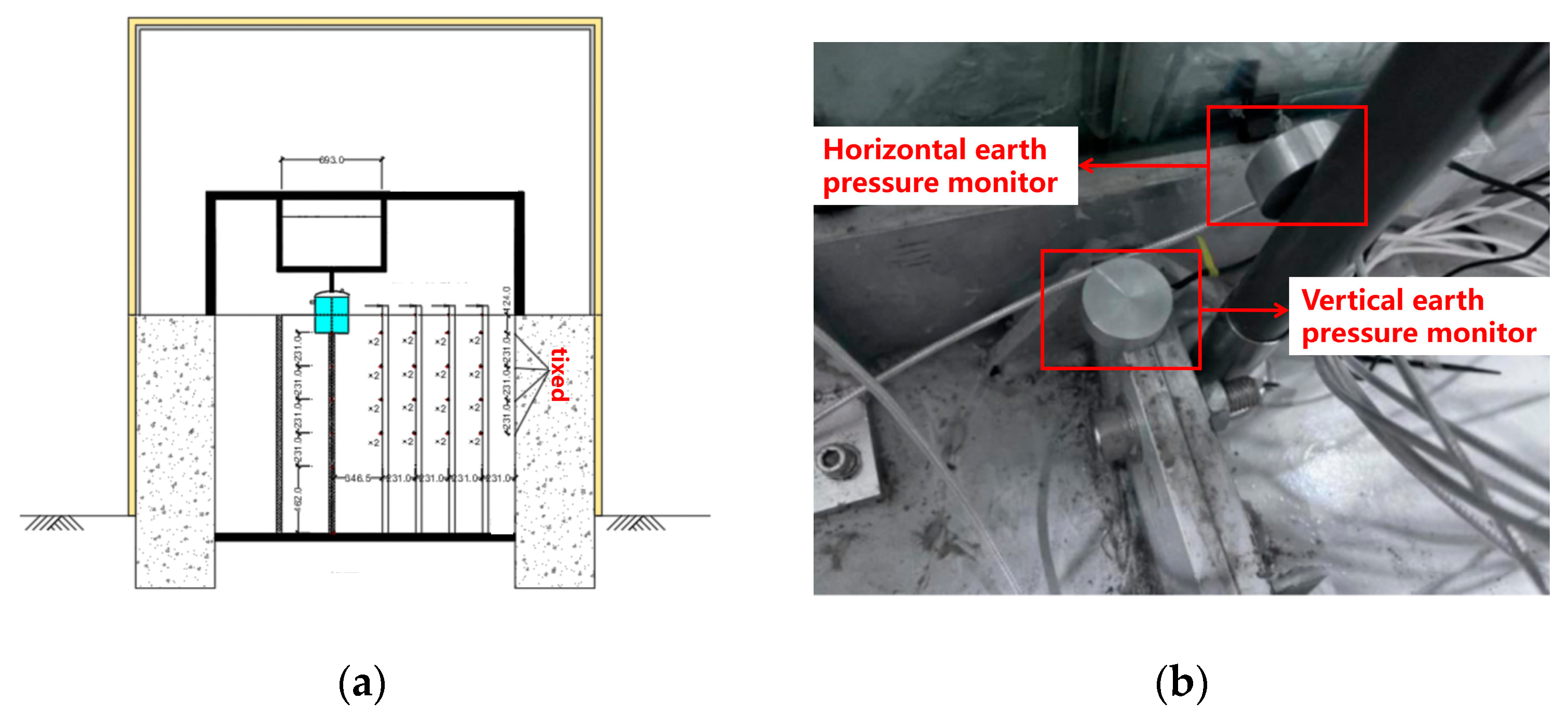
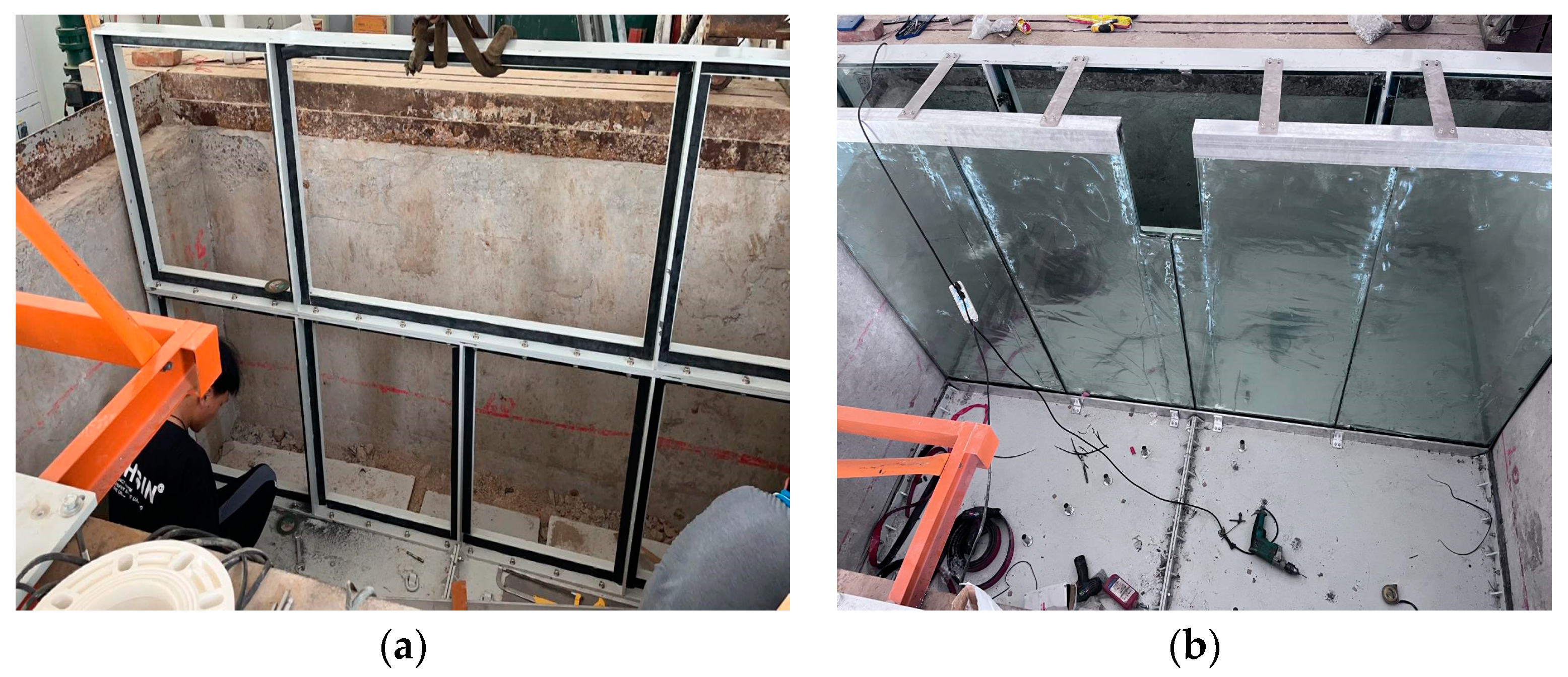
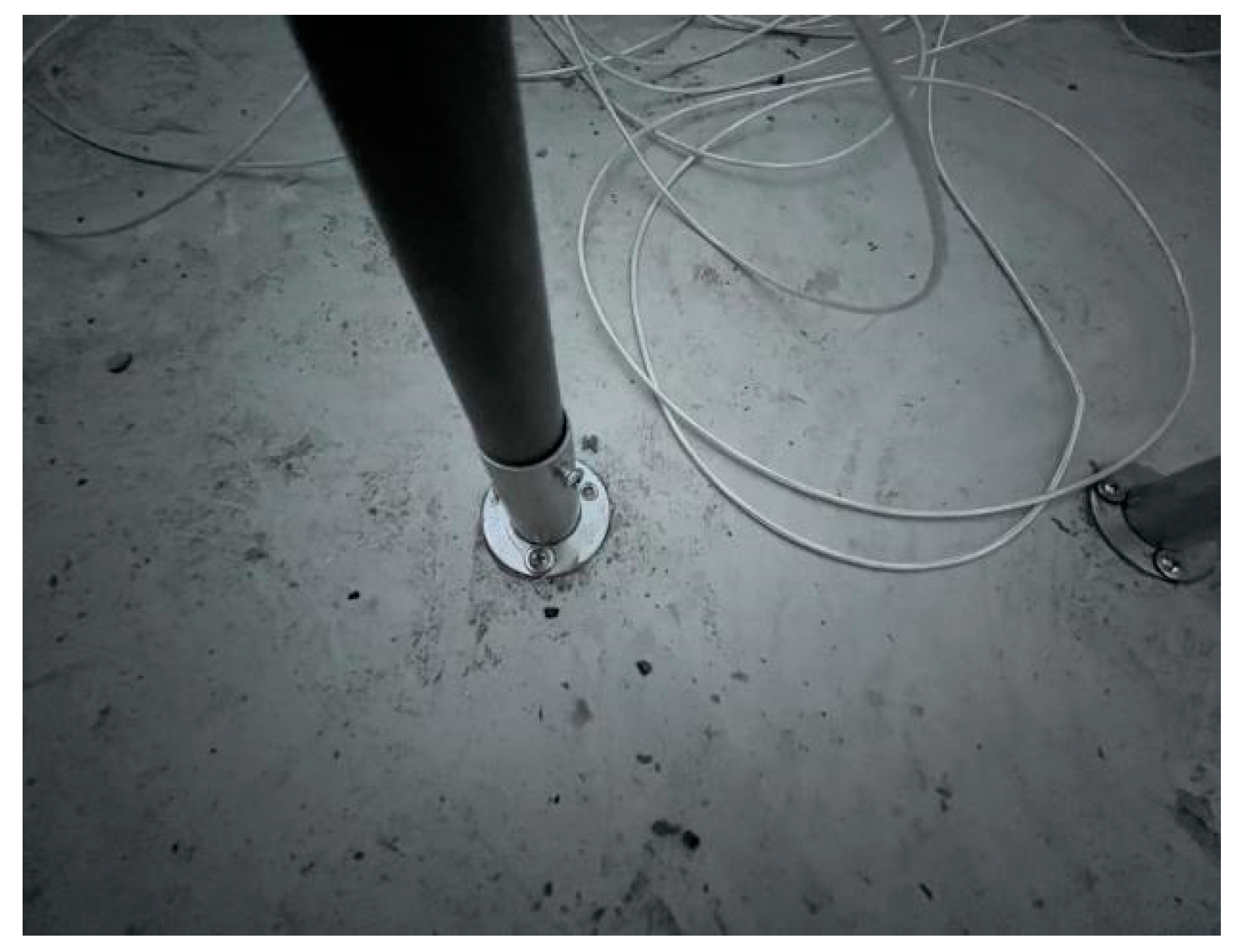
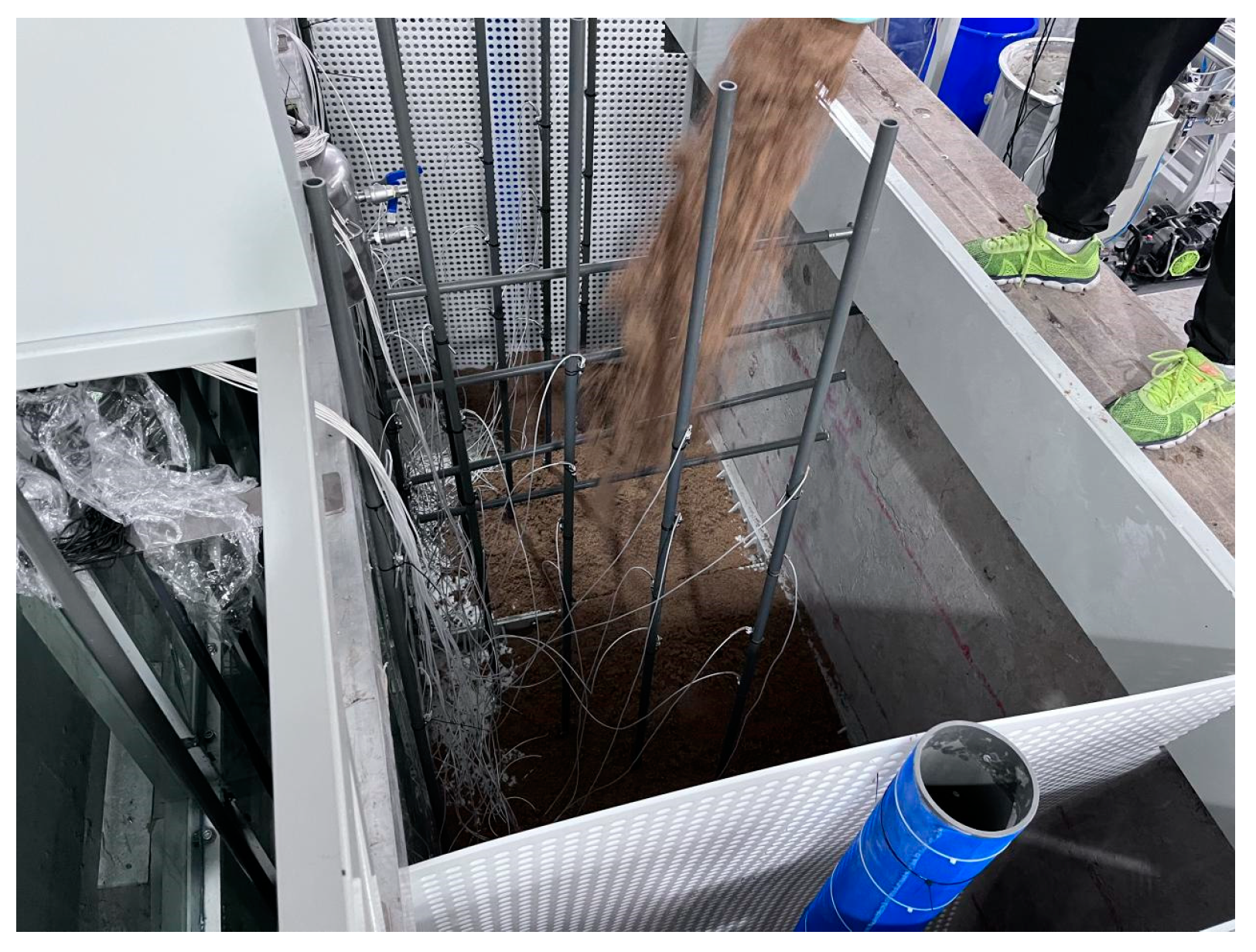

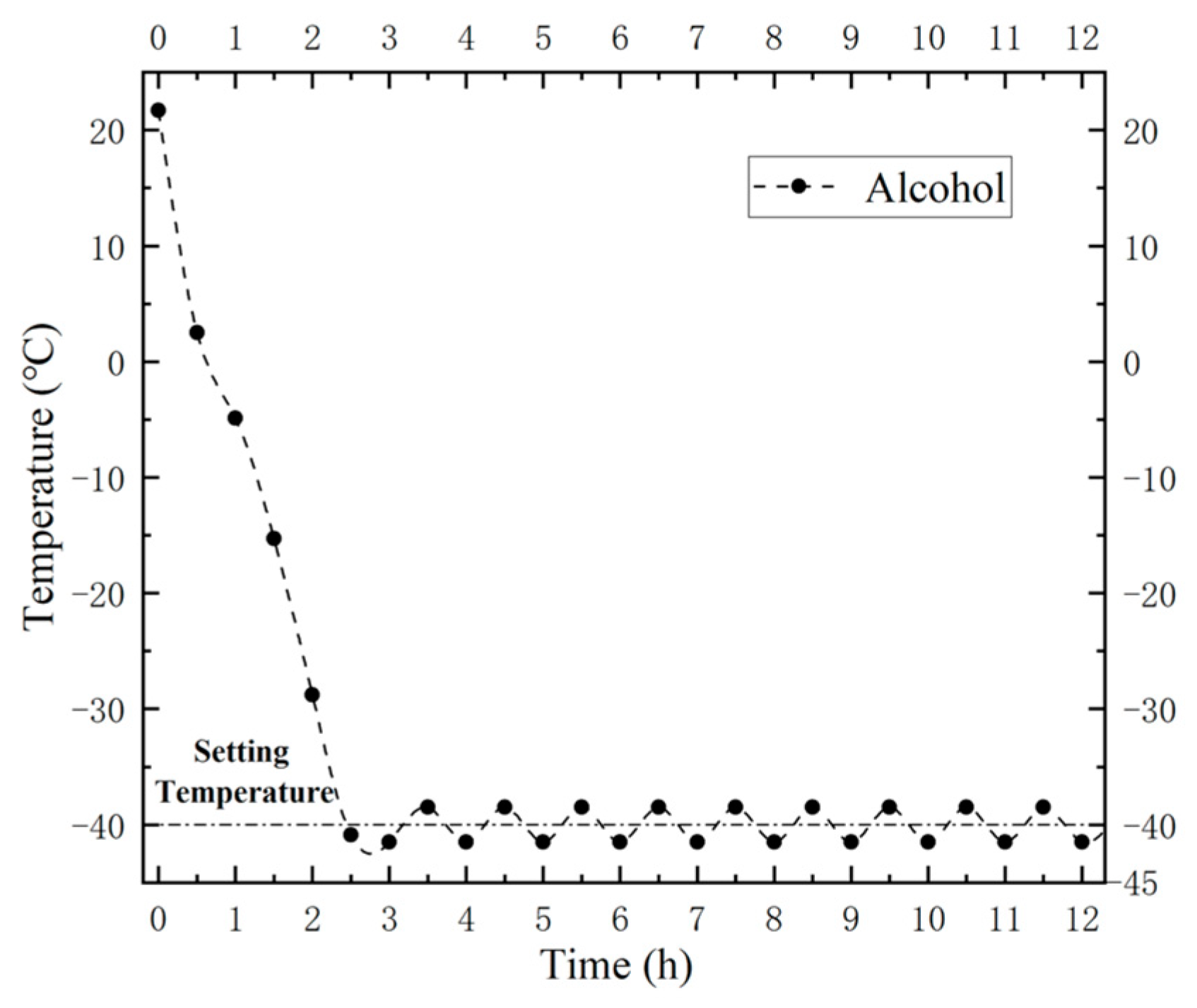
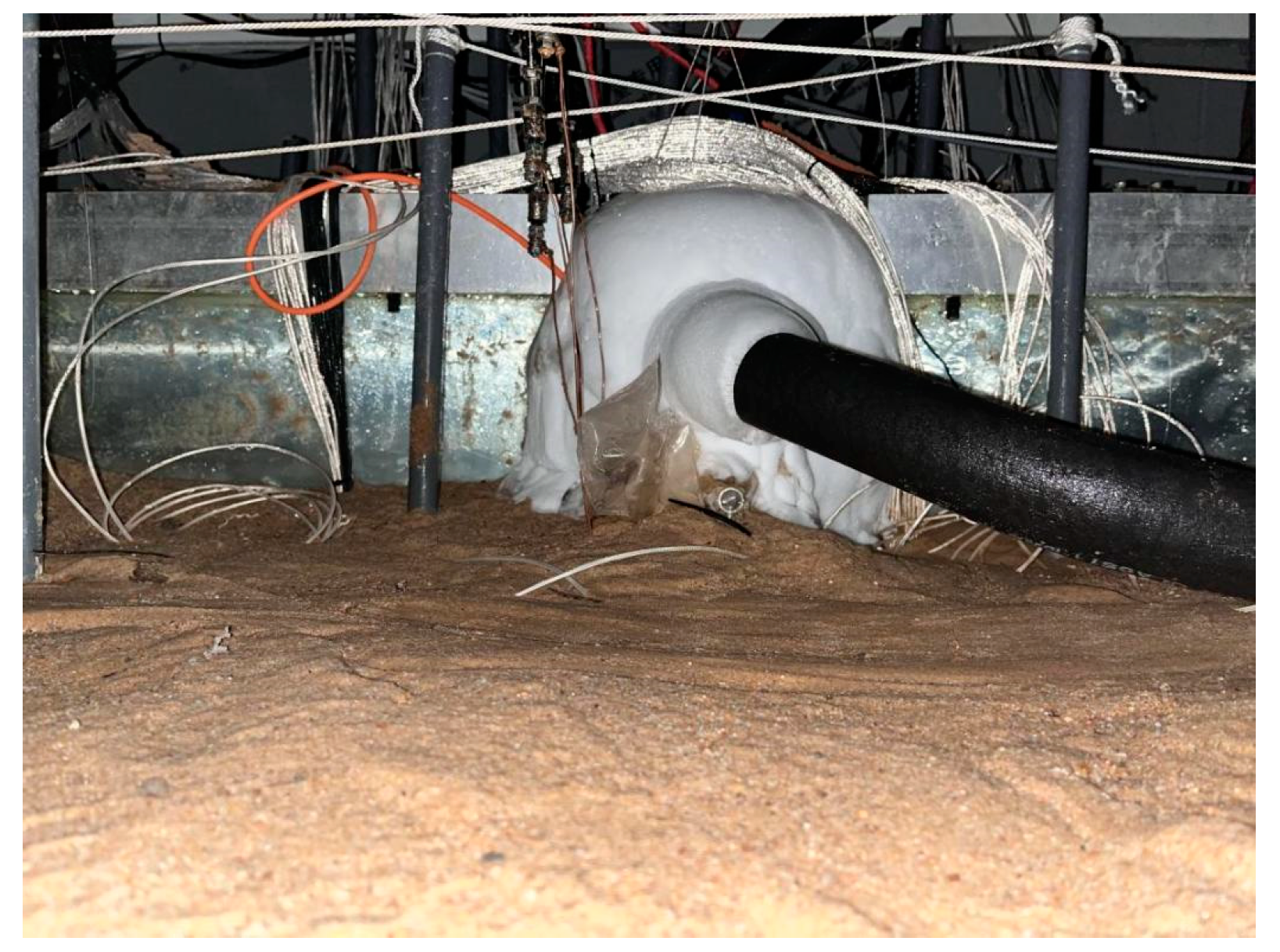





| Tank Structure | Size |
|---|---|
| Height of outer tank | 248.0 mm |
| Outer tank diameter | 231.0 mm |
| Inner Tank Height | 221.1 mm |
| Inner Tank Diameter | 228.6 mm |
| Outer Tank Thickness | 2.5 mm |
| Dome Side Height | 10.0 mm |
| Dome Height | 36.0 mm |
| Hours | Monitor 1 (mm) | Monitor 2 (mm) | Monitor 3 (mm) | Monitor 4 (mm) |
|---|---|---|---|---|
| 1 | 1209.84 | 1102.65 | 1206.30 | 1110.69 |
| 2 | 1203.33 | 1102.94 | 1201.00 | 1115.33 |
| 3 | 1197.31 | 1103.76 | 1197.08 | 1117.37 |
| 5 | 1190.33 | 1110.37 | 1187.88 | 1120.72 |
| 6 | 1185.31 | 1117.89 | 1182.21 | 1121.44 |
| 7 | 1180.08 | 1118.33 | 1176.34 | 1123.37 |
| 8 | 1176.32 | 1123.47 | 1171.17 | 1123.42 |
| 9 | 1172.01 | 1127.37 | 1168.88 | 1124.40 |
| 10 | 1169.38 | 1129.33 | 1167.76 | 1125.30 |
| 11 | 1167.20 | 1134.37 | 1162.67 | 1125.42 |
| 12 | 1161.00 | 1137.71 | 1158.34 | 1127.34 |
| 13 | 1159.37 | 1139.08 | 1153.77 | 1128.88 |
| 14 | 1158.30 | 1144.02 | 1147.59 | 1129.32 |
| 15 | 1157.05 | 1153.01 | 1141.20 | 1130.94 |
| 16 | 1156.71 | 1154.42 | 1139.60 | 1130.70 |
| 17 | 1156.78 | 1154.47 | 1139.58 | 1130.70 |
| 18 | 1156.72 | 1154.43 | 1139.57 | 1130.71 |
| 19 | 1156.71 | 1154.47 | 1139.50 | 1130.73 |
| 20 | 1157.21 | 1154.51 | 1139.51 | 1130.83 |
| 21 | 1156.70 | 1154.52 | 1139.47 | 1130.87 |
| 22 | 1156.71 | 1154.57 | 1139.43 | 1130.80 |
| 23 | 1156.70 | 1154.53 | 1139.40 | 1130.79 |
| 24 | 1156.71 | 1154.69 | 1139.38 | 1130.81 |
Disclaimer/Publisher’s Note: The statements, opinions and data contained in all publications are solely those of the individual author(s) and contributor(s) and not of MDPI and/or the editor(s). MDPI and/or the editor(s) disclaim responsibility for any injury to people or property resulting from any ideas, methods, instructions or products referred to in the content. |
© 2024 by the authors. Licensee MDPI, Basel, Switzerland. This article is an open access article distributed under the terms and conditions of the Creative Commons Attribution (CC BY) license (https://creativecommons.org/licenses/by/4.0/).
Share and Cite
Jin, G.; Xie, X.; Li, P.; Li, H.; Zhao, M.; Zou, M. Fluid-Solid-Thermal Coupled Freezing Modeling Test of Soil under the Low-Temperature Condition of LNG Storage Tank. Energies 2024, 17, 3246. https://doi.org/10.3390/en17133246
Jin G, Xie X, Li P, Li H, Zhao M, Zou M. Fluid-Solid-Thermal Coupled Freezing Modeling Test of Soil under the Low-Temperature Condition of LNG Storage Tank. Energies. 2024; 17(13):3246. https://doi.org/10.3390/en17133246
Chicago/Turabian StyleJin, Guolong, Xiongyao Xie, Pan Li, Hongqiao Li, Mingrui Zhao, and Meitao Zou. 2024. "Fluid-Solid-Thermal Coupled Freezing Modeling Test of Soil under the Low-Temperature Condition of LNG Storage Tank" Energies 17, no. 13: 3246. https://doi.org/10.3390/en17133246






